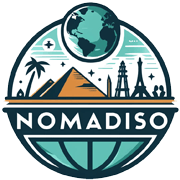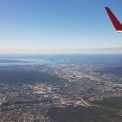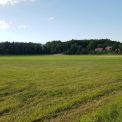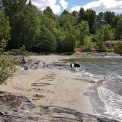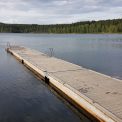A city breathing with modern technologies, riding the metro up the mountains, swimming in a fjord, cruising to green islands, or just chilling out in a park or by the lake. All of this and more can be experienced in the land of fjords, in the capital city of Norway, in the blue-green Oslo.
 Detailed map of our points of interest[/caption>
Detailed map of our points of interest[/caption>
Contents
Tips – Practical information
Day 1 – Holmenkollen, Vigeland Park and Huk Beach
Day 2 – Paradisbukta Beach and Bygdøy Sjøbad
Day 3 – Fram and Kon-Tiki Museums
Day 4 – Hovedøya Island, city center and Sognsvann Lake
Day 5 – Langøyene Island and Aker Brygge district
Day 6 – City tour with a free city guide
Practical information:
- You only need an ID card to travel to Norway
- Even though Norway is not an EU member, the roaming regulation applies, meaning you use data and calls as in the EU
- Oslo is one of the most expensive cities in the world, with accommodation prices starting at €40/night/person (if you’re two) or shared rooms from €30/night/person
- Free guided city tours in English (free city guide) start every day at 10:00 by the tiger statue in front of the main station
- Oslo Pass, costing around €42/24h, is worth it if you visit at least 3 museums in a day
- In summer, daylight is approximately from 4:00 to 23:00, and it stays light even after that, so you can plan activities from morning till late night 🙂
- You pay 20 NOK (around €2) for using the WC at the main station, but for example, it is free at the Town Hall
- You can pay by card everywhere, even for the mentioned WC
- Tax-free shopping – when shopping in a store with this logo, you can claim a tax refund at the airport, but the purchase from one store must be at least 315 NOK (around €33)
- Beer and wine are only sold in supermarkets until 17:00, and spirits only in specialized stores Vinmonopolet
Transport
- Tickets for public transport can also be bought through the app RuterBillett, saving you 50 NOK (around €5) for a chip card
- With the public transport pass, you have access to metro, buses, trams, and ferries – CAUTION – the only exception is the ferry to Bygdøy peninsula
- The best transfer hubs are the City Hall (Radhuset) and the main station (Jernbanetorget)
- To get to the Bygdøy peninsula, take bus no. 30 – best from the City Hall (Radhuset) or the main station (Jernbanetorget)
- Metro line no. 1 covers the largest height difference in the world from -9m to 469m and has the most beautiful track through nature (definitely go to the last stop Frognersetteren)
- Each seat on buses is equipped with a USB connector, so it’s worth carrying your cable (metros also have connectors at the ends of the carriages)
Day 1 – Holmenkollen, Vigeland Park and Huk Beach

You can find flights from Vienna to Oslo at the best price through the low-cost airline Norwegian. Landing at the main Oslo Airport Gardermoen, located around 50 km from the city, is advantageous. The second airport, Oslo Torp, served by Ryanair or Wizz Air, is up to 100 km away.
TIP: The cheapest and fastest way to travel from Oslo Gardermoen Airport to the main station is by NSB train (Norwegian State Railways) in 23 minutes for around 100 NOK (about €10) one way
If you opt for a taxi, upon exiting the terminal, there is an electronic board where you enter the destination address and it displays a list of taxis by price. Confirm your choice, and a taxi will arrive within a minute. For accommodation, we have two tips. For luxury, we recommend the Olympic accommodation Scandic Holmenkollen Park. For budget travelers, shared rooms (dormitory rooms) like Oslo Vandrerhjem Haraldsheim are a good option.
We recommend the Free city guide for a city tour. The first stop for today is the area of Holmenkollen, the highest part of the city, accessible by metro line no. 1 towards Frognersetteren.
TIP: Metro line no. 1 has the most interesting route to the mountains, where you will feel like you are riding a Tatra electric tram. I recommend taking a ride towards the final stop at Frognersetteren, but before the end, get off at the Skogen stop, from where you can enjoy a beautiful view of the lake.
Holmenkollen is best known for its ski jumping hills, especially the Holmenkollenbakken, which hosts the annual World Cup in ski jumping and cross-country skiing. The original hill dates back to 1892, with a new one built in 2010 standing at 134m (for comparison, the world’s largest is in Vikersund, Norway, at 240m). The hill also features the Holmenkollen Ski Museum with a view of Oslo, with an entrance fee of 140 NOK. And to keep the hill busy even in summer, they came up with another attraction – a zip line from the very top of the hill for 730 NOK.
Within the sports complex, there’s a track for cross-country skiers, a romantic chapel, and a smaller ski jump called Midtstubakken. People here are involved in sports from morning till evening.
From Holmenkollen, I move on to the Vigeland Park. The closest metro stop is Majorstuen, just a few minutes’ walk away. At the park’s entrance, you’ll find the Frognerbadet swimming pool. Vigeland Park is the world’s largest sculpture park created by a single artist Gustav Vigeland (1869 – 1943). The park contains 212 sculptures with over 600 figures. The most famous statue, also seen on postcards, is the sculpture of an angry boy. Following the bridge is a fountain undergoing reconstruction, so I can’t describe its full beauty, but it’s definitely worth a visit. Six titans carry a massive bowl from which water will flow. The masterpiece culminates in a 17m high monolith featuring 121 figures of men, women, and children of various ages. Further on, there are more sculptures depicting various combinations like man-woman, man-man, woman-woman, woman-child, families, etc. In the back of the park, you can see sundials with 12 zodiac signs and a circle of life created from more sculptures. By agreement with the city, there’s the Vigeland Museum located in the house where Vigeland lived and worked (entrance fee 80 NOK).
TIP: An alternative to Vigeland Park is Ekebergparken, which is not as mainstream but also boasts a nice collection of sculptures with a view of the islands. You can reach it by trams no. 18 and 19
The most beautiful and closest beaches are on the Bygdøy peninsula. Just take the bus no. 30 to the final stop – Huk stop. The first beach there, Huk beach, is about 5 minutes from the final stop, and is considered the most beautiful. Apart from several coves, its accessibility is a winner. The beach is sandy with dark sand.

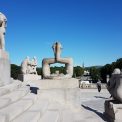


 You can wade into the water through the stony bottom or there is a ladder from the restaurant directly to deeper water. I took my swimsuit just in case, as the water was supposed to be around 17C according to the internet. In the end, it could have been around 20C near the shore, so I fully enjoyed swimming 🙂 In the parking lot at the Huk stop, you can admire electric cars, as there is a charging station here. Models like Tesla or BMW i3 are more common on this peninsula. Huk Beach also has its nudist section, so no one feels left out. I will save the other two beaches – Paradisbukta and Bygdøy Sjøbad – for another day. On the way home, I make a quick stop at a fast-food joint. You can get a cheeseburger in Oslo for 15 NOK.
You can wade into the water through the stony bottom or there is a ladder from the restaurant directly to deeper water. I took my swimsuit just in case, as the water was supposed to be around 17C according to the internet. In the end, it could have been around 20C near the shore, so I fully enjoyed swimming 🙂 In the parking lot at the Huk stop, you can admire electric cars, as there is a charging station here. Models like Tesla or BMW i3 are more common on this peninsula. Huk Beach also has its nudist section, so no one feels left out. I will save the other two beaches – Paradisbukta and Bygdøy Sjøbad – for another day. On the way home, I make a quick stop at a fast-food joint. You can get a cheeseburger in Oslo for 15 NOK.
Day 2 – Paradisbukta and Bygdøy Sjøbad Beaches

I take bus number 30 again to the Bygdøy peninsula. From the final stop, the road to Paradisbukta Beach leads right. It’s a pleasant walk through the forest with many paths where you’ll encounter runners or cyclists. If you stick to the main road, you won’t get lost, plus there are signposts. After about 10 minutes, you reach the beach itself. The left part is sandy, while the right side consists of stone slabs shaped by water erosion. There is, of course, a ladder to enter the water, so you don’t have to hesitate too much.
If you continue along the coast, you will reach Bygdøy Sjøbad Beach. It is again a sandy beach with yellowish sand and a very gradual entry into the water. Unlike Huk, it is more suitable for families with children due to its accessibility. The only downside, besides the accessibility, is that boats park there, but Norwegians surely insist on them being eco-friendly. You can return either by the same forest path or through the center of the island on open field paths. From the meadow, you have a view of the glistening diving bridge.
Day 3 – Fram and Kon-Tiki Museums

Today is forecasted to rain, so I plan to visit museums. By the way, a good weather app is the Norwegian Yr app. The most significant museums are on the Bygdøy peninsula. Among them, I mention the Fram Museum, Kon-Tiki Museum, and Viking Ship Museum.TIP: The combined ticket to the Fram + Kon-Tiki museums costs 220 NOK (separately you would pay 120 NOK + 120 NOK)
The Fram Museum is the most visited museum in all of Norway. You can go through the entire museum at a leisurely pace in 2 hours. Fram translates to forward, which perfectly captures its purpose in the conquest of the North and South Poles. It’s interesting that the museums were built around the ships and not the other way around. At the beginning, it’s worth waiting for the video where you can learn about the history of the polar ships Fram and Gjøa and the famous Norwegian explorers Nansen and Amundsen. Nansen made the first voyage on the Fram to the Arctic in the years 1893-1896, where the ship proved itself in extreme conditions. The most famous was the third expedition in the years 1910-1912 led by Roald Amundsen, who managed to reach the South Pole on December 14, 1911. He outpaced the English explorer Robert Scott, who arrived a month later, and unfortunately, his expedition perished on the way back.
The tour of the Fram starts on the deck of the ship, where you can grab the wheel or ring the bell. You continue down the stairs to the lower deck, where you can see the cabins, the dining room, or the technical rooms. Among the authentic items, there is, for example, a Singer sewing machine or a piano. The ship was very well sealed against the common -40°C temperatures in Antarctica, so after a while, we were sweating. During the museum tour, you can also see a life-sized polar bear. It was a feared creature by all polar explorers since an encounter with it would mean certain death. The good news is that there are no polar bears in Antarctica.
TIP: An interesting attraction is the cold simulator on the first floor. This is probably how sailors felt during the voyage to the South Pole. Make sure to try it, you can go through it comfortably in a T-shirt and a jacket. At the end of the tunnel, on the left before the exit, don’t forget to notice the polar bear.
The Kon-Tiki Museum is located right across from the Fram. Kon-Tiki was a balsa wood raft on which, in 1947, the Norwegian adventurer Thor Heyerdahl sailed with five other men from Peru to Polynesia. The expedition lasted 101 days, and the goal was to prove that the settlement of Polynesia was possible in ancient times.
The second boat in this museum is Ra, a reed boat (named after the Egyptian sun god). The first expedition in 1969 from Morocco to Barbados, led again by Thor Heyerdahl, was unsuccessful. However, these adventurers did not give up, and a year later with the improved boat Ra II, they covered the entire 6100 km journey in 57 days.
From the other famous voyages by Thor, I will mention the Galapagos, Easter Island, and the Maldives. In the museum, you can see the moai statues and even a cave from Easter Island, modeled after the real one with authentic paintings.
Day 4 – Hovedøya Island, city center and Sognsvann Lake

From the harbor near the town hall, boats depart to the islands of Lindøya-Nakholmen-Bleikøya, Hovedøya, Gressholmen, and Langøyene. Everything is covered by the public transport pass, and even the stops are announced in the same voice as if you were taking a bus. The frequency is approximately every 20-30 minutes, so you don’t have to worry about getting stuck on any island. The schedules can also be checked on Google Maps.
To the nearest island Hovedøya, shaped like the letter H, it takes a 10-minute ferry ride. The journey passes by the Akershus Fortress, which served as the city’s defensive stronghold from 1300. Upon disembarking, you are greeted by a pleasant green island where you can stroll, swim, or simply relax. The cleanliness and tidiness could serve as an example for many states. The island’s center features a path to the ruins of the 12th-century Hovedøya Abbey monastery.
The path continues towards sandy beaches. Whether you prefer a leisurely swim, a picnic, or further exploration of the island, it’s up to you. Heading left, you can walk to the southernmost tip, offering views of other islands. A path leads to a viewpoint with cannons and a magnificent panoramic vista, as the island served for many years as a military base. I definitely recommend not missing out on this. This is also my last stop, and I stroll back to the harbor along a forest path. Keep an eye on the boat departures on Google Maps to avoid unnecessary waiting time.
TIP: It is said that a fox lives on the island, often photographed and known to occasionally steal things, but I was not fortunate enough to encounter it (GPS route)
After disembarking, my itinerary includes a short walk through the city center. From the town hall, I walk towards the National Theatre, where the city’s imaginary diagonal begins. At one end is the royal palace, at the other a beautiful building housing the Norwegian Parliament. However, without a guide, it may not be as rewarding, so be sure to plan for the Free city guide, which concludes at the Norwegian Parliament. Behind the Parliament is a building with a large sign “Freia,” which was Oslo’s very first illuminated billboard.
Continuing on, you will reach the Oslo Cathedral. It is worth seeing, especially the stained glass windows by Emanuel Vigeland and the exceptional altar featuring a model of the Last Supper and Crucifixion by Michael Rask. Beyond the cathedral are shopping centers and the main railway station, so you can easily head to the opera house.Oslo Opera House is a modern building in the shape of a glacier. Unique features include a beautiful oak interior (entry is free) and the building’s roof, where you can climb, sit, and enjoy the views. The building also offers free Wi-Fi. Near the opera house, you can find a block of buildings known as Barcode, which from a certain angle resemble an actual barcode. Along the waterfront promenade, there is a path leading to the luxurious neighborhood of Sørenga, where one of the city’s two urban beaches, Sørenga Sjøbad, is located. The other one is Tjuvholmen Badeplass in the Aker Brygge district. Entry to both beaches is free.
The last item on today’s agenda is the Sognsvann Lake. Just take metro line 5 to the terminal station with the same name. Right at the beginning, you will encounter many ducks and swans that won’t refuse your hospitality. The lake has a 3-kilometer perimeter and is mainly frequented by runners since bicycles are not allowed. The pier and swimming ladders into the water are on the left side of the lake.
Day 5 – Langøyene Island and Aker Brygge District

Langøyene Island is a more remote uninhabited island with official camping possibilities. The boat trip takes approximately 20 minutes with a stop at Gressholmen Island. Langøyene is shaped like the letter H, just like Hovedøya Island. The difference is that the center of the island is not wooded, and after a large meadow, you are right on the beach. I also tried the trail through the forest on the left side of the island, but there are no viewpoints there.
At the other end of the island, there is a large sandy beach with a gradual entry into the fjord. The water here is noticeably colder than at Bygdøy Peninsula, but it would be a sin not to take a dip. In the middle of the bay, there is a pontoon where you can swim and relax. On the right side of the beach, there is a tent village.
TIP: Camping on Langøyene is free; you just need to adhere to the basic rulesYou can easily spend your entire stay here and save a fairly large portion on accommodation (GPS route)
On the way back, I meet a Slovak from Orava who programs CNC modules. Although he has been working in Oslo since last winter, this island was also his first time here.
Aker Brygge is a modern and luxurious neighborhood near the town hall. Wooden piers, parked yachts, futuristic architecture; I say to myself, this won’t be for the average person. The highlight is the Tjuvholmen district, which was transformed by a developer into an urban area with an artificial beach, sculpture park, and Museum of Modern Art. The sandy beach is more for families with children, while the wooden pier has ladders leading directly into the fjord. If I were to compare it with Sørengou, the environment is more beautiful, but also more crowded.
Day 6 – City Tour with a Free City Guide

Oslo free tour starts every day at 10:00 and 13:00 in front of the main train station – look for the statue of a large bronze tiger. I recommend filling the time before ten, for example, with a visit to the City Hall, which opens at 9:00 and is not as crowded. The tour of the main hall and upper floors takes about half an hour. The Nobel Peace Prize ceremony is held annually on December 10th in the City Hall. You can then take bus 30 or 31 to get to the main station.
TIP: Souvenirs, magnets, and postcards can be bought near the City Hall; there is also a tax-free shop.
Around the tiger statue, about 20 people have already gathered. We have a guided tour in English with a 100% Norwegian guide. In the introduction, we learn that Oslo got the nickname “Tiger City” from the Norwegian writer Bjørnstjerne Bjørnson, who described it as a cold and dangerous place. Near the station, there is a monument of a large hammer crushing a swastika as a symbol of resistance to Nazism.
The tour continues with other attractions:
- Oslo Opera House – a modern building shaped like an iceberg. Unique for its beautiful oak interior (admission is free) and the roof of the building, where you can climb and enjoy the views. The building also offers free Wi-Fi.
- Oslo Stock Exchange – a small inconspicuous stock exchange
- Town Hall no. 2 – now just a decaying building
- Christiania Torv – a bronze hand with a pointing finger, showing the spot where the then Danish-Norwegian King Christian IV decided to build the new Oslo after a massive fire destroyed the previous city. This square also hosted all trials and executions.
- Town Hall no. 1 – located left of Christiania Torv, now serving as a restaurant
- Akershus Fortress – a defensive fortress from 1300, now a museum with free entry
- Roosevelt Statue – Franklin Roosevelt made a great impression on the Norwegian people when he redeemed them from the negative perception of America during World War II
- Oslo City Hall – Town Hall no. 3 from 1950 is now the main city hall. The Nobel Peace Prize ceremony is held here annually on December 10th. The building is equipped with 49 bells that play tunes every hour. Free restrooms.
- Nationaltheatret – the national theater inaugurated in 1899 by main founders Ludvig Holberg, Henrik Ibsen, and Bjørnstjerne Bjørnson
- Carl Johan promenade – the imaginary diagonal through the city center
- Hard Rock Café – a stylish building at the opposite corner from the national theater
- Grand Hotel Oslo – a luxury hotel with bulletproof windows, where even Barack Obama stayed, worth peeking into the interior
- Storting building – a yellow parliament building from 1866, guided tours available on Saturdays and in the summer also on Sundays (GPS route)
I have expanded my free city guide with a visit to the Royal Palace, which is the current residence of the Norwegian royal family. You can stroll through a large green park with ponds and witness the changing of the guards. The last stop on my way to accommodation was the medieval stone church Kirkelig fellesråd built in 1080. It is the oldest building in the city.
My Nordic trip is slowly coming to an end. At the bus stop for the airport, there is a QR code where you can check the current location of the bus. And because it was delayed, I was calmer when I saw it on the map.
TIP: Taking the train is both cheaper and faster, so opt for the bus only if you are located far away
TIP: At the airport, they charge 30 NOK (over €3) for a half-liter of water, but there are also free water fountains, for example near gate D4 (ideal when you ask the cleaner)
